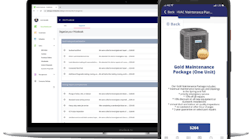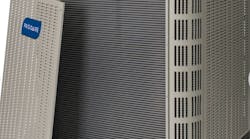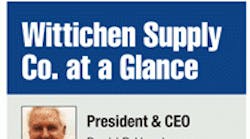Wittichen Supply Co. doesn't believe in the cookie-cutter model of doing business. Whether it's running their branches or working with customers, Wittichen Supply conducts its business by focusing on what the customers and the markets want. For a business that began nearly 100 years ago as a small division of a chemical company and evolved into selling HVACR parts and pieces and, later, equipment, Wittichen Supply has forged its own path to success.
The Birmingham, AL-based distributor has grown to 25 branches in Alabama, Georgia and Florida and is known among customers for having inventory that is both wide and deep. “We have it at the point of sale when the customer needs it and not a day away,” says Charles Herring, general manager of Wittichen Supply. “We have the A's, the B's and C's and sometimes the D's and E's all at the point of sale where the customer needs it.”
Wittichen Supply began in 1914 as part of the Wittichen Chemical Co., a chemical distributor founded by Carl F. Wittichen. It was the Wittichen Co. that pioneered the first use of the chemicals Anhydrous Ammonia, Sulfur Dioxide and Methyl Chloride for refrigerant systems in 1930. As air conditioning began to come into wider use in Birmingham, it was Wittichen that stocked all of the refrigerants, parts, supplies and equipment that serviced the industry. It was also the start of long-term relationships with major manufacturers such as DuPont, Allied Chemical Co., Honeywell, White-Rodgers, Johnson Controls and Tecumseh Compressors.
Wittichen Supply remained a distributor of parts and pieces for air conditioning equipment until the 1970s, when it added an equipment line. As Herring tells it, Wittichen Supply got into the equipment business as a defensive move since most of the air-conditioning companies had started selling the parts and pieces. “That's what started our venture into the equipment business,” Herring says.
At the end of the 1970s, Wittichen Supply faced another significant challenge when one of its founders and the face of the business, Drexel Daily, passed away. The loss of such a beloved and respected figure caused some in the industry to question if the business would survive. Daily's sudden death put David Henderson, the son-in-law of Carl Wittichen, in charge. Having only joined the company two years earlier, the plan had been to groom him as a successor, but circumstances called for an acceleration to the executive change. “The company did not miss a beat,” Herring says, “and we've continued to grow and thrive and expand. We miss Mr. Daily, but the company has continued to be very successful.”
Almost since Wittichen Supply split off from Wittichen Chemical Co. in the 1950s, it has expanded throughout Alabama and, more recently, beyond state lines. In the 1960s, Wittichen Supply expanded into the northern part of the state. In the early to mid-1980s, it expanded south. In the 1990s, Wittichen filled in the gaps around the state and established satellite branches. In the 2000s, the expansion was into west Georgia and the Florida Panhandle. Currently, Herring says the business is looking where it can best fill some of the gaps in its coverage.
Herring says Wittichen Supply has always gone to new markets with a mix of their people and local people. “We feel that's the best approach for us,” he says. The Wittichen Supply veterans know the Wittichen way and how they do business, while the locals best know the customers.
Page 2 of 4
Because the local markets are so varied, Wittichen Supply gives its branch managers the ability to run the branches as they see fit. “Giving those branches the autonomy to tailor the inventory for their markets is instrumental to our success in those markets,” Herring says. For example, northern Alabama is a big package unit and heat pump market, while central Alabama has a lot of natural gas heating, and southern Alabama is a mix of systems. “Some markets even 30 or 40 miles apart can be different with what their product niches are,” Herring says.
While other distributors may go to market with a standard set of products and SKUs, “we don't have that cookie-cutter inventory that is determined by the corporate office that we then try to get out to 25 branch locations. It doesn't work that way. They have the flexibility to tailor their inventories for their specific markets,” he says.
As part of this individualized branch approach to each market, Wittichen Supply's outside salespeople work directly with the branches and report to the branch manager and not a sales manager. “It makes for a good team,” Herring says. “The branch managers are there running the operation and making sure the inventory and the right people are in place, and the sales guys work closely with them to go after new business.”
The 28-member sales team, Herring notes, is larger than most sales teams for the market area served by Wittichen Supply. Working together, the branch comes up with the marketing approach to best serve the particular market. “The outside salespeople work closely with the customers on their needs. They're able to sit down with them and tailor programs specifically for those customers,” Herring says.
There's no sales manager, regional managers or vice presidents at Wittichen Supply. In fact, there's not much of a central management team at all. Henderson has been the president since the passing of Dailey in 1979 and Herring, who joined the business in 1973, is the general manager. That's it. “There aren't a lot of levels here,” he says. At Wittichen Supply, the power is with the branches.
Unlike most companies with multiple branch locations, Wittichen Supply doesn't rely on centralized purchasing or a central warehouse. “They do their own purchasing at that level and bring products into their own warehouses,” Herring says. Because the branches have their own inventories, they tend to keep more of it in their warehouses and, thus, have more on hand.“Our branches are much larger with more people who have more longevity. The typical national wholesaler will come in with smaller branches and less inventory.”
Page 3 of 4
Having the inventory in place for customers has become an important differentiator as they compete against the national chains that may go to market with smaller stores. Herring acknowledges that the chains have the ability to beat distributors on price for their “bread and butter” items. “So we have to make sure that we, whether it's through buying groups, are able to leverage what else we do to stay competitive with them other than through those A and B items,” Herring says. To help maintain an even larger inventory base, Wittichen Supply is a member of the Key Wholesale Group.
Herring is also proud of the long-term relationship that Wittichen Supply has built with more than 650 premium HVACR brands of equipment, parts, accessories and components. “These are long relationships with valued vendors to make sure that we have the well-recognized brands in the industry,” he says. Wittichen Supply has purposely avoided the low-priced and no-name brands because there's no value in them for customers. “We feel that partnering with the premium brands, the people and those companies that are recognized in the industry is what we need to do.”
Even if Wittichen Supply could make larger margins off cheaper brands, Herring says there's too much at stake. “Names, reputations, warranties all matter,” Herring says. “I want to sell to our customers again and again, and we can't afford to sacrifice our reputation and the quality of the items that are unknown and untested.”
Having these long-term relationships requires frequent and open communications with the manufacturers, Herring says. Over the years, there have been issues related to quality, pricing and others, but they've always been able to work out those issues. “We're in it together and we have to survive it together,” he adds. “Rather than throw them out the door, we sit down at the table with them and work out our problems.”
Wittichen Supply had a record year for sales in 2010, which followed a slight dip in 2009. He says the markets served by Wittichen Supply did not suffer as much as those larger markets in major metropolitan areas. He also credits its diversified business and not being so involved in the residential new construction markets as reasons for their ability to survive the recession relatively unscathed. “Most of our business has been service and replacement oriented even on the equipment side,” Herring says. “We've been focused on the change-out and service markets and not residential new construction.”
Herring points to the experience of the people as another important differentiator. These are people, he says, with 20, 25 or even 30 years of experience. It speaks to the value that customers get from this experience, but it also demonstrates the loyalty that goes both ways between the employer and employee. Herring says that Wittichen Supply designed its benefit packages to reward and retain employees who give the business its reputation among customers.
Wittichen Supply continues to invest in customer service training for all of its employees, from the inside and outside sales representatives to those in the accounts receivable and credit collections. Herring calls it an ongoing process and an important part of the three-legged stool of customer service, people and inventory.
While Wittichen Supply has been able to retain its best people, Herring is concerned about the ability of the HVACR industry to continue to attract quality young people. He says the customer base tends to be older, and there are fewer young service technicians coming into the branches.
This is true in the distribution business as well. As his people with 30 and 35 years begin to retire, Herring says he has to prepare those midlevel employees to provide the knowledge to the younger generation. As he notes, it takes years of experience to master the industry. “You don't get that in just five years,” he says. “We're trying to put programs together to show them that there's value there and reward them for knowledge and experience.”
Michael Maynard is a contributing editor based in Providence, RI. He writes frequently on HVACR, construction and architecture issues. Contact him at [email protected].
Page 4 of 4
Best Practice
Our branches do their own purchasing and have the autonomy to tailor their inventory for their specific markets and customer needs.
Definition and Example: Rather than having a central distribution center and centralized purchasing by purchasing agents in our corporate office, our branches do their own purchasing at the individual branch level and bring their inventory in directly from the manufacturers.
Significance: This allows them to better tailor their inventory based on their specific market and the needs of their customers. They have the autonomy to make important inventory decisions right there in the marketplace, as opposed to a purchasing agent somewhere else, who may not even be familiar with the market.
Benefits: The most important benefit is that it puts the inventory at the point of sale where the customer needs it, instead of in some distribution center somewhere, where the customer might have to wait a day to get it.
Procedure: We built our own point-of-sale system from the ground up and enable our branch managers with the tools they need to look at and monitor sales history, trends, etc., and make purchasing decisions based on that. Each day they can look at inventory levels, and our system can automatically build purchase orders for them based on current needs, and they can then tweak them as needed.
People involved: Primarily the individual branch managers. Depending on the size of the branch, they assign some purchasing responsibilities for some product lines to other key personnel in the branch.
Timing: The tools are in place to allow them to look at this daily and not have to spend much time on it at all.It allows them to be very efficient. By spending a little time on this daily, it allows them to have what their customers need, when they need it, without being grossly overstocked on anything.
Cost: The main cost is that we carry more inventory than a typical HVACR distributor would, because it is at the individual branches instead of consolidated in a DC. With that, there is some duplication. The company is well-financed and has no debt. There is nothing we can invest in that gives us any greater return on our investment than inventory. When we are heavy in inventory as opposed to not having what the customer needs when he needs it, the customer wins. It is hard to find a downside to the customer winning.
Other considerations: When our branches are overstocked on items, they show up as surplus when any other branch attempts to order them from the manufacturer. This allows them to pull surplus they need right away from another branch that may have more than they need. In most cases, they can get them much faster than ordering them directly from the manufacturer. This helps alleviate too much duplication of inventory.
Contact: Charles Herring, general manager, 205/278-3720, [email protected] or visit www.wittichen-supply.com.










